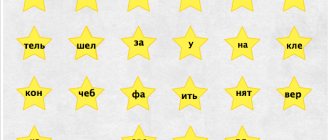Introduction
The problem of studying and correcting specific disorders of written speech (dysgraphia and dyslexia) in children is still one of the most pressing problems in speech therapy. Every year in primary school the number of children with various types of dysgraphia increases. Based on the mechanisms of each type of dysgraphia, the authors who devoted their research to this area of speech therapy (R.I. Lalaeva, V.A. Kovshikov, I.N. Sadovnikova, I.N. Efimenkova, G.G. Misarenko, A.N. Kornev, etc.). They offer various methods of correction work.
A set of manuals designed for working with children with optical dysgraphia is offered to the attention of specialists. The kit includes methodological recommendations, notes from frontal correction classes and two individual workbooks for the child to complete tasks. These manuals represent practical material systematized by the author and are compiled taking into account methodological requirements.
In the optical form of dysgraphia, children experience disturbances in visual perception, analysis and synthesis, as well as motor coordination, inaccurate ideas about shape and color, the size of an object, underdevelopment of memory, spatial perception and ideas, difficulties in optical-spatial analysis, and unformed optical image of a letter. Mixing letters based on kinetic and optical similarity should not be mistaken for ordinary “misprints,” since they are not related to either pronunciation or spelling rules. Such errors can lead to a decrease in the quality of not only writing, but also reading. A child’s writing impairment is persistently systemic, so correctional work should be aimed at the speech system as a whole, and not just at eliminating an isolated defect. The use of manual materials in work will allow the speech therapist to carry out effective correctional work throughout the year and will help to track. dynamics of the state of the child’s written speech.
Learning not to confuse letters, Album 2, Exercises to correct optical dysgraphia, Mazanova E.V., 2006
Learning not to confuse letters, Album 2, Exercises to correct optical dysgraphia, Mazanova E.V., 2006. Album of exercises No. 2 is included in the set of manuals for overcoming the optical form of dysgraphia in children of primary school age. The use of manual materials in work will allow the speech therapist to carry out effective correctional work throughout the year and help track the dynamics of the child’s written speech. The set of manuals can be used by speech therapists of mass and correctional schools, and students of defectology departments. LAUNDRY "EGOR AND SONS". On the bank of a forest river, under the sign “Laundry - Egor and Sons,” every day early in the morning a family of raccoons sat down and began noisy washing. But one day daddy raccoon came up with the idea to name his sons Yegor, Zakhar and Evgeniy with unusual names. The first began to be called Epiphanius, the second - Elistratus, and the third turned into Eulampius. And the laundry got up. Every morning now began with the raccoon dad remembering the names of his children. But after thinking for five hours and still not remembering anything, he realized that this was an impossible task. He decided to put crosses next to the names of his children, but this did not help him either. He can barely find the cross and the bookmark, but there’s no time to wash it. There are animals walking around in dirty clothes, and the laundry is standing still. One day, while the raccoon dad was not at home, a hedgehog came to visit the raccoons, he asked to give him a book with unfortunate names. The raccoons happily agreed. But the kids were afraid of dad. Then the hedgehog decided to cheat; he asked to wash the book, saying that it was dirty. The cubs set to work on their favorite task, and soon the book was washed. They washed the book so successfully that all the letters were erased. Daddy Raccoon is back. I looked at the kids’ work, felt sad, but had nothing to do, and began calling my children by their usual names: Egor, Evgeniy and Zakhar.
Download the e-book for free in a convenient format, watch and read: - fileskachat.com, fast and free download.
Below you can buy this book at the best price with a discount with delivery throughout Russia. Buy this book
How to open a file
Copyright holders
- djvu - Yandex.Disk. - pdf - Yandex.Disk.
Publication date: 07/23/2021 06:16 UTC
textbook on pedagogy :: pedagogy :: Mazanova :: dysgraphia
See also textbooks, books and educational materials:
- Learning not to confuse sounds, Album 2, Mazanova E.V., 2006
- Learning not to confuse sounds, Album 1, Mazanova E.V., 2006
- Speech therapy, Dysgraphia caused by a violation of language analysis and synthesis, Mazanova E.V., 2006
- Speech therapy, Dysgraphia caused by a violation of language analysis and synthesis, Notebook No. 1, Mazanova B.V., 2006
The following textbooks and books:
- How to engage in self-education, Rubakin N.A., 1962
- Information and communication technologies in education, Dendev B., 2013
- Correction of optical dysgraphia, lesson notes for younger schoolchildren, Mazanova E.V., 2006
- Learning through entertainment, Edutainment camp as a technology of modern education, Golyshev G., Poplavskaya K., Eroshina Y., Mikheeva E., Mytarev I., 2021
Previous articles:
- Programming technology, Basic C/C++ constructs, Educational reference manual, Lipachev E.K., 2012
- Pedagogy and psychology of higher education, Androgogical paradigm, Samoilov V.D., 2017
- Fundamentals of pedagogy and psychology, Divnenko O.V., 2021
- Practice of modern education, Petrusevich A.A., Lorenz V.V., 2012
<< Previous articleNext article >>
Speech therapy work to prevent optical dysgraphia
A large number of studies and publications are devoted to the problem of preventing writing disorders in children, but the relevance of its study does not decrease. An analysis of the literature showed that many scientists were studying the prevention of dysgraphia: E. M. Gopichenko, G. I. Zharenkova, A. A. Leontyev, R. A. Luria, A. K. Markova, K. N. Monakhov, L. K. Nazarova, V. Morgan, N. A. Nikashina, E. F. Sobotovich, L. F. Spirova, O. A. Tokareva and others. I. N. Sadovnikova, E S. Bolshakova, A. V. Yastrebova. M. A. Povalyaeva, N. A. Kornev.
The possibility of preventing dysgraphia is quite real, because all future difficulties in writing can be almost accurately predicted already in preschool age, even determining the type of future dysgraphia. Optical dysgraphia can appear in children if there is an immaturity of visual analysis and synthesis, spatial representations. It manifests itself in mixtures and substitutions of similar graphically handwritten and printed letters. All this is accompanied by disorders of various types of memory, attention and emotional-volitional sphere. This type of specific writing impairment, unlike the others, is not associated with the state of oral speech. In these cases, a child with sufficient visual acuity does not see the difference in the outline of optically similar letters, which leads to their replacement in the letter or to the incorrect spelling of some letters.
To prevent optical dysgraphia, it is necessary to develop visual-spatial concepts in the child, which will give him the opportunity to notice differences in the outline of mixed letters.
In order to study speech therapy work on the prevention of optical dysgraphia, we carried out experimental work on the basis of the Municipal budgetary preschool educational institution of combined type kindergarten No. 1 in Kurganinsk, Krasnodar Territory, from September 2014 to May 2015. The subjects were 12 children with level 3 OHP preparatory group. Of these, four children made up the experimental group (EG-1), and four children with whom the preschool speech therapist worked according to the traditional system made up the group (EG-2), the remaining 4 preschoolers who did not have speech disorders made up the control group (CG).
The ascertaining experiment was carried out in September-October 2014.
To achieve this goal, we selected methods to identify the prerequisites for optical dysgraphia. These techniques are aimed at identifying violations of spatial perception, the formation of visual perception and the preference for lateralization. These included:
- The methodology for studying the formation of visual-spatial representations included the following tasks:
The child must follow the instructions:
a) Show in the picture where the pencil lies on the book, where under the book, and where in the book;
b) Invite him to put the pencil on the book, under the book and in the book;
c) Ask the child to take a pencil from a book, from under a book, from a book.
Difficulties in completing tasks may indicate insufficient development of the child’s visual-spatial concepts, expressed in a lack of understanding of the location of objects in space in relation to each other.
- The technique, aimed at identifying the ability to navigate in the sides of space, included the following tasks:
a) Place the pencil to the right of the book and ask the child to do the same with his pencil.
b) Fold two pencils (counting sticks) in the form of a printed letter “G” and ask the child to do the same with his pencils (counting sticks), and then fold the letter “I” in the same way. The mirror performance of these tasks will indicate difficulty in differentiating the left and right sides of space.
These tasks allow you to identify the correct orientation of the child in the sides of space.
- The methodology for determining the integrity of the perception of space (synthesizing individual parts into a whole object) included tasks:
a) Ask the child to say how (what details) two similar pictures differ from each other. To find all these rather small differences, the child must have a fairly developed visual analysis.
b) Invite the child to put together an object using children’s cubes according to the pattern. To complete this task, the child must be able to synthesize individual parts into a whole object.
The examination of each preschooler was carried out individually, in a friendly atmosphere, starting with establishing contact through a conversation, the content of which was determined by the child’s emotional state, his motivation, and readiness to get involved in work. The entire examination took no more than 20 minutes, and the tasks gradually became more difficult.
Visual material was selected for each series of tasks. During the survey, play techniques were used to stimulate children's activities. Instructions for completing the tasks were divided into 2-3 short sentences, each of which did not exceed 5-6 words.
In case of difficulties, the child was provided with measured assistance (from repetition of instructions and additional stimulation to the introduction of learning elements). This made it possible to identify areas of not only current, but also immediate development of the child. At the same time, the provision of assistance did not involve direct prompts to children and correction of their mistakes during the examination.
When children performed tasks, the following results were obtained: the prerequisites for dysgraphia were identified in 8 children of the experimental groups (EG-1, EG-2), in 4 preschoolers the prerequisites were not found (CG). Two children (Veronica and Milana) from group EG-1 showed an average level of success in completing tasks, and two other children (Alexander and Denis) had a low level. A similar situation was observed in children from EG-2, where two children, Bogdan and Dmitry, showed an average level of success in completing tasks, and two other children, Alexey and Victoria, showed a low level.
Having analyzed the results of the ascertaining experiment, we identified the following prerequisites for optical dysgraphia:
- Insufficient development of visual-spatial concepts;
- Difficulty differentiating the left and right sides of space;
- Inability to synthesize individual parts into a whole object;
- Impaired coordination of movements and fine motor skills of the hands.
The formative experiment was carried out on the basis of the Municipal budgetary preschool educational institution of combined type kindergarten No. 1 in Kurganinsk, Krasnodar Territory from October 2014 to April 2015.
The purpose of the formative experiment is to carry out corrective work to eliminate the prerequisites for optical dysgraphia in children with ODD in the preparatory group of a preschool educational institution.
To achieve the goal, the following tasks were set:
— to develop a set of didactic exercises aimed at preventing optical dysgraphia in children with ODD in the preparatory group of a preschool educational institution;
— organize and conduct experimental training;
— conduct a control experiment to evaluate the effectiveness of the proposed corrective measures.
The principles and methods of correctional work by R. I. Lalaeva, V. A. Kovshikov, I. N. Sadovnikova, I. N. Efimenkova, G. G. Misarenko, A. N. Korneva, E. V. Mazanova and etc.
Correctional work consisted of 3 stages, each differing in tasks, content, and volume of absorbed material. The content of training at each of the previous stages prepared children for the passage of new, more complex material.
Stage 1 – preparatory – formation of skills and abilities necessary to prevent dysgraphia at the elementary level. At this stage, we developed visual perception of objects and learned to explain the relative position of objects in space. To do this, they explained and showed the meaning of the prepositions on, above, under, in, with, from under, between, through, because of, etc.
Stage 2 – the main one – continuation of work to prevent dysgraphia only at a higher level. At this stage, we taught children to determine the sides of space from themselves. At the beginning, we worked on the “body diagram” with the children, i.e. they had to remember where the right hand was, where the left hand was and everything on the right, left, above, below. These concepts were reinforced in the children’s speech. After familiarizing ourselves with the “body diagram,” we moved on to sketching on a piece of paper, as directed by the speech therapist: techniques for developing hand-eye coordination.
Stage 3 – final – improvement of speech therapy work to prevent dysgraphia and its consolidation.
Directions of correctional work:
- Development of visual perception and object recognition in children.
- Formation of spatial perception and ideas:
- Development of hand-eye coordination.
A series of didactic exercises have been developed for each stage.
The formative experiment program was built taking into account general didactic principles (consciousness and activity in learning, visibility, accessibility, systematicity and consistency, individual approach, etc.) and special correctional principles (systematicity, complexity, taking into account the causes, mechanisms and structure of speech defects, differentiated approach and etc.), which determine: the development and correction of children’s visual perception and recognition of objects (development of visual and letter gnosis), the formation of spatial perception and ideas, the development of visual-motor coordination.
All correctional work was carried out with preschool children with special needs in the preparatory group on the basis of the Municipal budgetary preschool educational institution of combined type kindergarten No. 1 in Kurganinsk, Krasnodar Territory, identified on the basis of a preliminary study of the state of readiness of children to master writing.
In the course of our work, we tested a set of didactic methods and exercises aimed at preventing optical dysgraphia in children with ODD in the preparatory group of a preschool educational institution, implemented all stages of training, after which a control experiment was carried out.
The control experiment was carried out in May 2015.
The purpose of the control experiment is to evaluate the effectiveness of the developed set of didactic exercises.
Eight children from the preparatory group took part in the control experiment: EG-1 – children who were trained in the formative experiment, and children from EG-2 who did not take part in the formative experiment.
When conducting the control experiment, the methods of the ascertaining experiment were used.
In the ascertaining experiment, 50% of children had a low level of success in completing tasks aimed at identifying the prerequisites for optical dysgraphia, 50% of children had an average level. Now, in the control experiment, those children who were at an average level rose to a high level - 50% of children (Alexander Ch. and Denis Ch.), and children from a low level rose to an average level - 50% of children (Veronica T. and Milana T. ).
Thus, the results of the speech therapy study indicate positive dynamics in the development of the formation of visual-spatial concepts; differentiation of the sides of space; synthesizing individual parts into a whole object; impaired coordination of movements and fine motor skills of the hands.
Most children now have a high and average level of development of visual-spatial concepts; differentiation of the left and right sides of space; synthesizing individual parts into a whole object; impaired coordination of movements and fine motor skills of the hands, while in preschoolers EG-2 such significant positive dynamics were not revealed, despite the fact that traditional speech therapy work was carried out with them.
The correct organization of work to prevent optical dysgraphia in children with ODD in the preparatory group of a preschool educational institution, close interaction between teachers, and high-quality differential diagnostics made it possible to make the optimal choice of methods that are adequate to the structure of the defect and the age of the child, which explains the high efficiency of the work and the stability of the results. The timeliness of the measures taken and the cooperation of specialists ensure the full development of the child, which we were convinced of by comparing the results of the initial diagnosis, before the start of experimental training, and the control one, after the implementation of the system of speech therapy work.
Correction of agrammatic dysgraphia
Correctional work involves speech therapy principles of work. The main directions of correctional speech therapy: overcoming oral speech defects, development of language analysis and synthesis, word formation, development of spatial-analytical activity with the help of games for spatial orientation, improvement of the intellectual sphere, development of grapho-motor skills.
The formation of the grammatical side of speech is realized through a system of gradually more complex oral and then written exercises. Moreover, each task includes a sample of its implementation and a detailed oral explanation. By regularly completing assignments, students begin to understand language patterns and develop the skill of using grammatical forms correctly.
Correction of agrammatic dysgraphia includes:
“Correction of optical dysgraphia in older preschoolers and younger schoolchildren” (from work experience)
« Correction of optical dysgraphia in older preschoolers and younger schoolchildren
»
(from work experience)
Writing is a complex skill that involves making fine, coordinated movements of the hand. When writing, it is especially important to form the entire complex of the child’s readiness: a combination of the tempo and rhythm of speech with the movement of the eyes and hands, the ability to control the hands and fingers, learning to write the basic elements of letters, familiarization with the hygienic rules of writing, the working line, various subject images close to the configuration of letters .
The study and correction of specific disorders of written speech in children is currently one of the main problems of speech therapists and primary school teachers. Every year, the number of children with dysgraphics and dyslexics at the primary level increases, who, due to the specific nature of the speech disorder, have serious difficulties in mastering the school curriculum.
Dysgraphia is a partial disorder of the writing process associated with insufficient formation (or decay) of mental functions involved in the implementation and control of written speech.
Dysgraphia is manifested by persistent, typical and repeated errors in writing, which do not disappear on their own, without targeted training.
What does this look like in practice?
Features of optical dysgraphia:
- in replacing graphically similar handwritten letters consisting of identical elements;
- does not complete elements of letters, for example “G” instead of “P”;
— adds extra elements to letters;
- does not connect letters;
- confuses printed and written letters;
- mirror writing of letters.
Optical dysgraphia stands apart from all other types. This type of dysgraphia does not depend on the state of oral speech and can occur in children even with the highest level of its development.
To overcome optical dysgraphia, it is necessary to carry out consistent, systematic correction work in the following areas:
1. Development of visual perception, recognition of color, shape and size (visual gnosis);
2. Expanding the volume of visual memory;
3. Formation of spatial and temporal representations;
4. Development of visual and auditory analysis and synthesis;
5. Development of graphomotor skills, mastery of graphic symbolization;
6. Differentiation of letters that have optical and kinetic similarities.
Corrective work to overcome optical dysgraphia requires the elimination of violations of sound pronunciation, the development of phonemic processes, vocabulary, grammar, coherent speech, and non-speech functions.
Such children can fully master writing, provided they continue to study diligently. For some, months of study are enough, for others it will take years.



